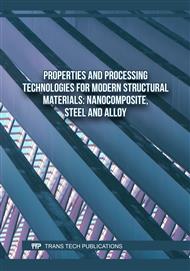p.1
p.15
p.25
p.35
p.43
p.53
Comparative Study between Thermo-Mechanical and Inherent Strain Method in Analysing Part Distortion of WAAM Component Using Numerical Simulation
Abstract:
This research investigates the part distortion of WAAM process by utilizing advanced numerical simulation. The WAAM component is made of a stainless steel SS316L deposition layer that is deposited on top of a mild steel S235 substrate plate to create a hollow, rectangular structure with a thin wall. In this study, Goldak's double-ellipsoid was used as the heat source model, and an isotropic hardening rule based on the von-Mises yield criterion was used. MSC Marc/Mentat is utilized as the numerical FE software for this research. The commercial S235 mild steel for substrate and the evolved SS316L was scanned by JMATPRO as the input for material modelling. In order to reduce the computational time of the numerical WAAM process, an Inherent Strain Method (ISM) is proposed for a numerical WAAM simulation in Marc. There are two ISM methods proposed for this study, the first is the analytical ISM based on the calculations and second is the calibration-based ISM using Virtual Calibration Test (VCT). On obtaining the ISM value based on the result of VCT, the mathematical software MATLAB were utilized to find the optimized ISM value. This research has a final purpose to determine which numerical simulation model that has a clear advantage on predicting the component deformation result in term of result accuracy as well as computational time. The expected final outcome of this study is the implementation of ISM method on numerical WAAM simulation is able to predict a part distortion in an accurate manner similar to TMM model with significantly faster computational time. Keywords: WAAM, Part Distortion, Numerical Simulation, Inherent Strain Method, Computational Time.
Info:
Periodical:
Pages:
25-34
Citation:
Online since:
June 2024
Price:
Сopyright:
© 2024 Trans Tech Publications Ltd. All Rights Reserved
Share:
Citation:


